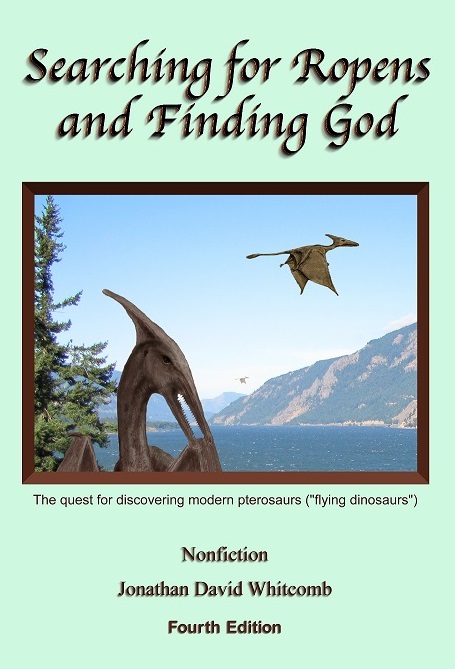By living-pterosaur researcher Jonathan Whitcomb
Introduction
I was delighted to discover, earlier this week, the Youtube video “PNG Expedition 2015 Documentary (Milt Marcy).” I talked with Milt Marcy and Peter Beach, by phone, soon after they returned to the USA from their expedition on New Britain Island, Papua New Guinea, in 2015, yet I believed I was under some restrictions at the time, regarding revealing names of people and names of locations where sightings had taken place. Some years earlier, I had told another living-pterosaur investigator that I would keep certain details secret, at least for a time, regarding sightings in earlier years in that area, at his request. That time is past. With the production of this documentary (mostly about a more-recent sighting, during an expedition in 2015), restrictions seem to have been lifted.
I can attest to the honesty-credibility of both Milt Marcy and Peter Beach, for I have communicated with them for years. In fact, they took me with them on a mini-expedition in Washington state in 2014, giving us much time to talk. In addition, I have found these two men to be objective, unlikely to misidentify a non-pterosaur. Before I met them, they had gone to central Africa together, as part of an expedition team in search of the Mokele-mbembe (apparently a living dinosaur). In other words, these are experienced cryptozoologists.
I don’t know any details about how my two associates arrived on New Britain Island, but by helicopter Marcy and Beach arrived at a remote village on March 19th. Six days later, on March 25th, they had a dramatic sighting of an apparent large pterosaur (but not a ropen) flying far overhead.

Still image from the video footage (recorded on New Britain by Peter Beach)
.
Testimonies in, and Related to, the Documentary
Although the flying creature was soaring high in the sky, there were few clouds, and they were at first above the apparent pterosaur. Marcy and Beach got to look at it for at least two minutes or so before it soared up above the scattered clouds.
When it got directly overhead, Marcy was able to clearly see the appendages on the front of the wings: apparent claw-hands. A number of natives were also there to witness what the two Americans were observing on March 25, 2015. This sighting was in daylight.
I talked with Beach by phone on August 16, 2018, and he verified that what they had observed was very unlike a frigatebird (sometimes spelled as two words: frigate bird). The apparent pterosaur had a wingspan that appeared to be twelve feet, much larger than a frigatebird. It also had the following differences:
- The head differed
- The tail differed
- The wings differed
- It changed the shape of its wings during flight
Peter Beach is a biologist and had been a biology professor at a small college. He knows what a frigatebird looks like. In fact, he had observed those oceanic birds not long before they had arrived in that remote village. I no longer here use the phrase “apparent pterosaur,” not because I am 100% convinced that this particular flying creature was a non-extinct pterosaur: because the possibility appears to be far above 50%. What the two American explorers observed on March 25, 2015, also differed significantly from eagles and vultures.
Some of the older natives in this area of New Britain were well aware of these flying creatures. They told Beach about the egg laying and nests. Beach himself saw one or two nests (probably two):
I saw two trees that had big nests at the center . . . [explaining what he meant by “center”] maybe the tree was 200 feet tall . . . about 100 feet [above the ground] there was this large nest that had been broken by the hurricane. . . .
Was it a Ropen?
This kind of question is bound to come up. Strange to tell, but the pterosaur observed for a few minutes by Milt Marcy and Peter Beach, deep in the jungle of central New Britain, was not apparently the same species seen on Umboi Island, the long-tailed ropen that has also been seen on the mainland of Papua New Guinea and on Bougainville Island.
Indeed, most sightings of apparent modern pterosaurs in the Southwest Pacific seem to be the large (or huge) long-tailed type that my associates and I have connected with what are called Rhamphorhynchoid pterosaurs. In other words, fossils demonstrate that two basic types lived in the past, and modern human eyewitnesses make it clear that the same two types are still living.
.

Milt Marcy (left) and Peter Beach are shown being interviewed (in a Youtube video)
###
.
Pterosaur Expedition in Papua New Guinea
Three Americans explored a tropical rain forest in Papua New Guinea, within the past few weeks, and two of them succeeded in observing an apparent living pterosaur.
.
Late in 2006, Garth Guessman, a living-pterosaur investigator, interviewed three Americans who had worked in or visited a medical mission in Central New Britain Island, Papua New Guinea. The three had separate sightings, in daylight, of what may be extant (non-extinct) Pterodactyloids. (short-tailed pterosaurs, a.k.a. “pterodactyls”)
.
Pterosaur expedition in Papua New Guinea (video)
Milt Marcy and Peter Beach on New Britain Island, PNG, searching for a living pterosaur—this Youtube video includes their video footage of what is probably a modern pterosaur.
.
. . . in 2009 Rex, a native of Tarawe Village and a student at a university on the mainland, during one of his trips between the city of Lae and Umboi Island saw the ropen. He and others on the boat observed the ropen on the south coast of the island, although only its tail was above the surface of the water when they passed by in the banana boat. The ropen still lives there.
.
The credibility of sightings of living pterosaurs
. . . a skeptic replied to the Youtube video of the 1944 “pterodactyl” sighting in New Guinea. He proposed that the encounter (west of Finschhafen, New Guinea) was just a misidentification of a bird . . . The Great-billed Heron (Ardea sumatrana) has practically no head crest at all, nothing like what was chosen by Hodgkinson in his responses to the detailed questionnaire. [In addition, no heron has a tail “at least” 10-15 feet long.]
.
Living pterosaur investigators
This page on cryptozoologists includes Milt Marcy and Peter Beach. (“About Us”)
.
Credibility of non-extinct pterodactyls
Let’s examine an individual sighting report and its credibility: an account of an apparent living pterosaur in Spain. (I’ve already written much about the overall honesty-credibility of the reports, so we’ll here concentrate on this individual account.)
.
The ropen: is it a modern pterosaur “myth?”
Brian Switek made some serious errors of judgment in his “Don’t Get Strung Along by the Ropen Myth.” It was the August 16, 2010, posting on the Smithsonian Magazine, online publication. I would now like to comment on some of those errors.
.
Pterodactyloids and Rhamphorhynchoids in Papua New Guinea
Could living pterosaurs still fly through the skies? This is an investigation in the realm of cryptozoology. (“Flying Dinosaurs in Papua New Guinea”)
.
Do Reports of Live Pterosaurs Come From Lies?
Soon after I had returned from my expedition on Umboi Island, I saw that somebody had published an online article attacking the possibility of modern dinosaurs and pterosaurs, with a URL containing the words “stupid” and “lies.” [This is a reply to that careless criticism]
.
Dinosaur living on New Britain Island
From a handbook of dinosaurs, the Therizinosaurus was chosen, although the eyewitness pointed out that the head in the book differed from what he had seen.
.
_____________________________________________________________________________
.

Searching for Ropens and Finding God, fourth edition
.
Quoting from this nonfiction cryptozoology book (page 130):
After our 2004 expeditions, Guessman, Woetzel, and I continued sharing news about sightings and about our individual investigations. Late in 2006, Guessman sent me copies of two interview reports, and a third followed early in 2007. To us, accounts of pterosaur-like creatures in Papua New Guinea no longer shock but these three accounts came close, for a tail-less pterosaur appears to fly on the island of New Britain—a non-ropen.


